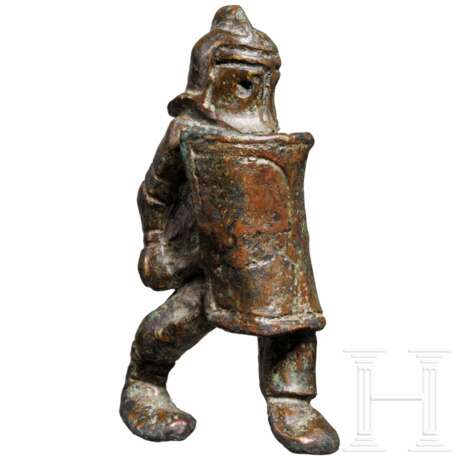Bronzestatuette eines Gladiators der Gattung "Provocator", römisch, 2. - 3. Jhdt. n. Chr.
19.11.2024 10:00UTC +01:00
Classic
Sold
2750EUR € 2 750
| Auctioneer | Hermann Historica |
|---|---|
| Event location | Germany, Grasbrunn / München |
| Buyer Premium | 25 % |
Archive
The auction is completed. No bids can be placed anymore.

ID 1323298
Lot 4087 | Bronzestatuette eines Gladiators der Gattung "Provocator", römisch, 2. - 3. Jhdt. n. Chr.
Schreitender Gladiator mit eng am Körper geführtem Schild und dahinter, in leicht angewinkeltem Arm versteckt, geführtem Kurzschwert in der typischen Ausrüstung eines Provocators: Visierhelm mit tiefgezogenem Nackenschutz, Pektoral, dessen typische Verschnürung auf dem oberen Rücken zu sehen ist, während das Pektoral selbst durch den eng am Körper geführten Schild verdeckt ist, linke Beinschiene, mittelgroßer Rechteckschild sowie Kurzschwert. Der Helmkamm könnte auch für einen Secutor (auf den Kampf mit einem Retiarius spezialisierter Murmillo) sprechen, da die Kalotte bei Provocatores glatt verläuft, das Pektoral spricht jedoch für einen Provocator. Eine für den Murmillo typische, den linken Arm vollständig schützende Manica ist nicht eindeutig zu erkennen, es handelt sich eher um Armbänder oder Verschnürungen, wie sie ähnlich auf einem Grabrelief aus Civitavecchia an Provocatores zu sehen sind. Dunkelgrüne Patina mit rötlichen Oxydflecken. Höhe 8,2 cm.
A Roman bronze statuette of a gladiator of the "Provocator" type, 2nd - 3rd century A.D.
A Roman bronze statuette of a gladiator of the "Provocator" type, 2nd - 3rd century A.D.
Striding gladiator with a shield held close to his body and, behind it, a short sword hidden in his arm, which he holds at a slight angle, wearing the typical equipment of a Provocator: a visor helmet with deeply drawn neck guard; a pectoral, whose typical lacing can be seen on his upper back while the pectoral itself is concealed by the shield held close to his body; the left greave; a medium-sized rectangular shield and a short sword. The helmet comb could also indicate a secutor (a Murmillo specially trained to fight a retiarius) as the skull worn by Provocatores was smooth; the pectoral suggests a Provocator, however. The manica, which would be typical for the Murmillo and completely protects the left arm, cannot be clearly identified; it is more likely to be wristbands or lacing, similar to those seen on Provocatores on a tomb relief from Civitavecchia. Dark green patina with reddish oxide spots. Height 8.2 cm.
Condition: I - II
| Place of origin: | Roman Empire |
|---|
| Place of origin: | Roman Empire |
|---|
| Address of auction |
Hermann Historica Bretonischer Ring 3 85630 Grasbrunn / München Germany | ||||||||||||||
|---|---|---|---|---|---|---|---|---|---|---|---|---|---|---|---|
| Preview | |||||||||||||||
| Phone | +49 (0)89 5472 649 0 | ||||||||||||||
| Fax | +49 (0)89 5472 64999 | ||||||||||||||
| Buyer Premium | 25 % | ||||||||||||||
| Conditions of purchase | Conditions of purchase | ||||||||||||||
| Business hours | Business hours
|


